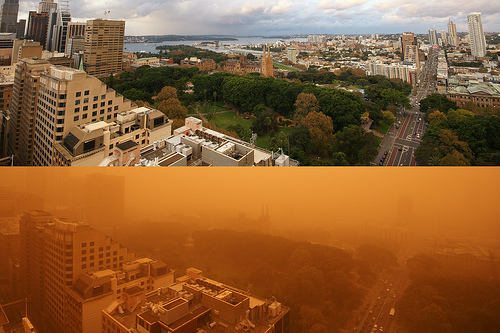
image © Karen Brook
In my work I am trying to characterise aeolian signatures in marine sediments.
You can find more information about my dusty studies at www.nioz.nl/dust
It’s now recognised that aeolian dust may have a large influence on the Earth’s climate, through for example its effects on the earth’s albedo e.g., through particles suspended in the atmosphere, and by particles deposited on glaciers, or by the fertilizing potential that chemical elements adsorbed to wind-blown particles may have.
Please find an impressive movie here that I found on youtube.
It’s a couple that drive (by car) into a dust storm near Broken Hill, Australia:
By collecting dust in the source areas, I try to understand what are the effects of dust formation, entrainment and transport on the particles that make it out to sea.
By collecting present-day dust from the atmosphere, I try to ground-truth the inferences I make from wind-blown dust found in deep-marine sediments.
By collecting / monitoring dust deposited on the ocean, I try to understand the consequences and marine-environmental effects of dust deposition.
Together with Patrick De Deckker (ANU, Canberra, Australia) and Australian and German colleagues I was awarded an ARC grant to study Australian dust. In June 2007 we had our first field trip. There were four more field trips in September 2007, March 2008, February 2010 and June 2013. All in all we learned a lot from these field trips, especially about the enormous differences in source areas and their resulting dust emissions. It also gave us a fair understanding of how large dust outbreaks like the €’red-dawn event’ in September 2009 can happen.

image © ABC News
By collecting dust offshore NW Africa for the first time during expedition M41 (1998) with the German Research Vessel Meteor, we demonstrated that meteorology plays a key role on both the quantity and quality of the dust that is transported in dust outbreaks. Especially the altitude on which the dust is transported is of vital influence to e.g., the size of the dust. With the new array of instruments between Africa and the Caribbean, we can now show how ’giant’ particles (>75 µm) can be transported across 1000’s (thousands!) of km across the ocean.
Dust outbreaks are obviously widely studied through satellite images, but one of the disadvantages of these studies is the lack of control on the altitude at which the dust moves. By using weather balloons that were launched from the ship, we have an idea about the vertical structure of the atmosphere and hence could define the layer of maximum transporting capacity. Thus we could show that it is the Trade-wind layer that carries the bulk of Saharan dust into the Atlantic Ocean, and not e.g., the Saharan Air Layer (SAL), which travels at much higher altitudes.
Animation © NASA
Dust is a hot topic at the moment, due to the many aspects one can study. I enjoy discussing with and learn from others people’s experiences, especially in fields that I don’t have access to that easily. For different scientific organisations like INQUA and EGU, I have initiated and co-organised scientific sessions during large international meetings. Here I got to learn about:
- dust and medicine:
- respiratory problems caused by dust:
- Shin in 2001, states that Trinidad has the highest amount of patients suffering from asthma, caused by Saharan dust,
- The pesticides used for agriculture in former Russia, that have flown into the Aral Sea are now released and dispersed by winds due to the drying up of the sea,
- dispersal of microbes along with dust particles:
- Griffin in 2001, states that outbreaks of foot-and-mouth disease in the UK can be linked to Saharan dust,
- Blackband disease in corals around Barbados are thought to be caused by Saharan dust,
- modern dust:
- there is a multitude of people studying present-day dust downwind of large deserts:
- collecting it from the atmosphere,
- collecting it in sediment traps hanging in the ocean,
- studying it(s effects) in corals,
- satellites are excellent tools to study sources and dispersal patterns of dust, but also to study the reflected heat by dust particles in the atmosphere, although some people also claim that the radiative properties of dust clouds are far more complicated; dust can also heat up the atmosphere
- biologic effects of dust:
- dust fertilisation:
- since the postulation of the Iron hypothesis by Martin & Fitzwater in 1988, there have been many experiments testing the effect of iron additions to the oceans, although there is still no consensus on the fact if the net carbon export also increases with increased productivity,
- Koren and co-authors, in 2006, state that the Amazon rainforest is fertilised by Saharan dust
- past dust:
- there are many possibilities to study past dust deposition in:
- lake sediments,
- marine sediments,
- loess (onland dust deposits)
Back in 2004, Maarten Prins and I have started organising topical scientific sessions on aeolian dust for the EGU meeting in Nice, and continued to do so since. During the Fifth Assembly of the European Geosciences Union (EGU), in April 2008, Andreas Baas, Peter Knippertz and I for the first time have organised an interdivision session on Aeolian dust, incorporating the three divisions geomorphology (dust as initiator of environmental change atmospheric sciences (dust as player of e.c.) and climate (dust as recorder of e. c.), and repeated that session every year. This merger resulted in really interesting interdisciplinary sessions, which we’ll repeat for the 17th time in 2020.
Besides, in 2000 we have set up a theme in G3 on Aeolian dust, see the G3 website for these publications.
Elsevier also picked up the growing interest for aeolian research by launching the new journal: Aeolian Research
If you have any questions, please do not hesitate to contact me!
